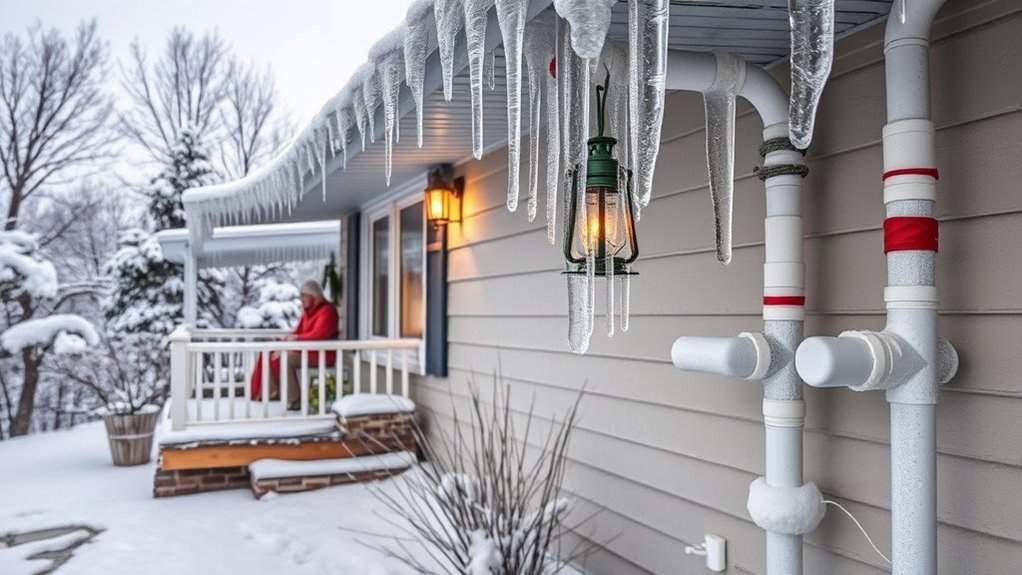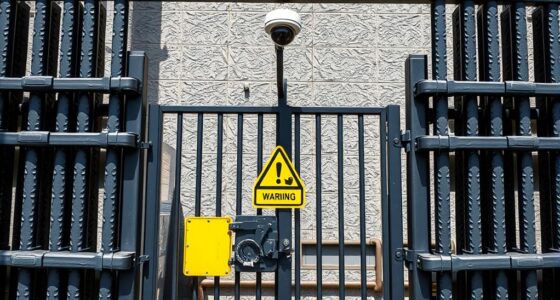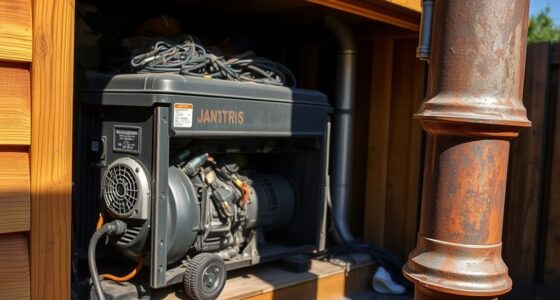To prepare for ice-storm outages without frozen pipes, insulate and seal your home to retain warmth, especially around pipes. Keep indoor temperatures steady, let faucets drip slowly, and shut off outside water sources before a storm hits. Use safe heating devices like space heaters and heat tapes to prevent freezing. Stay informed about utility updates and make sure your emergency kit is stocked. Want to know more strategies? Keep going for detailed tips.
Key Takeaways
- Insulate exposed pipes with foam sleeves or self-sealing tape to prevent freezing during outages.
- Keep indoor temperatures between 55-65°F and open cabinet doors to protect plumbing.
- Let a small trickle of water run from vulnerable faucets to prevent freezing.
- Shut off external water supply and drain outdoor lines and hoses before an ice storm.
- Use UL-listed heat cables or portable heaters safely to maintain pipe warmth without risking fire.
Insulating and Sealing Your Home to Keep Pipes Warm
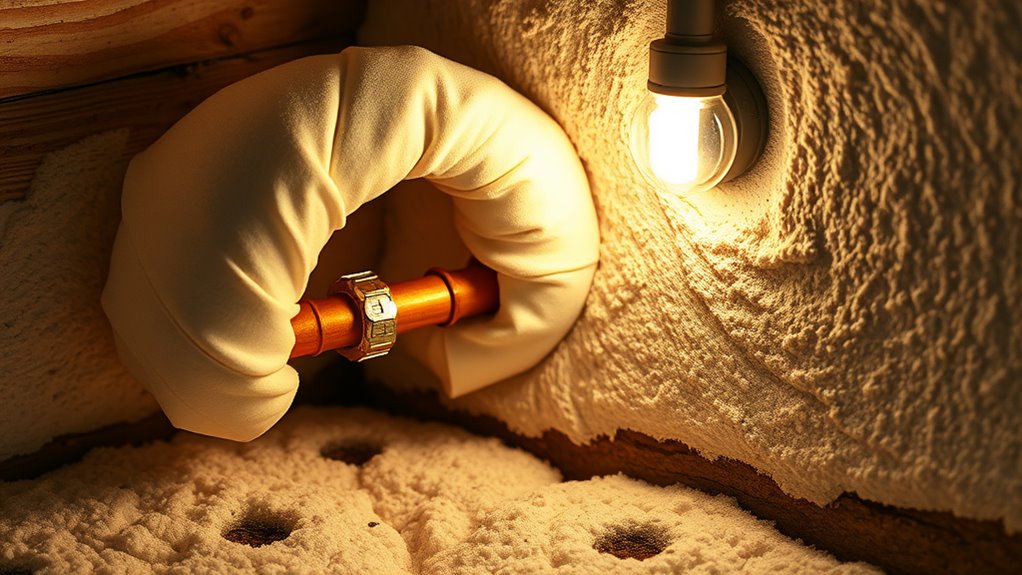
Insulating and sealing your home effectively can prevent pipes from freezing during an ice storm. Start by applying foam pipe insulation, which is lightweight, flexible, and easy to slide over pipes in basements and garages. For extra protection, use fiberglass pipe wrap in areas prone to extreme cold or moisture, but be prepared for more challenging installation. For irregular pipes or hard-to-reach spots, self-sealing insulation tape offers a secure, adaptable solution. Make sure to seal all gaps around pipes, including openings for cables, outside faucets, and wall penetrations, using caulking or expanding foam. Close crawlspace vents and ensure exterior doors and windows are tightly sealed. These steps help keep cold air out and maintain warmer conditions around your pipes, reducing the risk of freezing. Proper insulation is essential to creating an effective barrier against the cold and maintaining a safe temperature for your plumbing. Additionally, verifying your home’s air sealing helps improve overall energy efficiency and prevents drafts that could lower indoor temperatures further. Implementing home insulation practices can also contribute to the overall effectiveness of your winter preparedness and can be optimized using AI-driven insights to identify vulnerable areas. Incorporating vertical storage solutions for any supplies or tools needed during winter can also help keep your space organized and accessible.
Managing Indoor Temperature and Water Flow
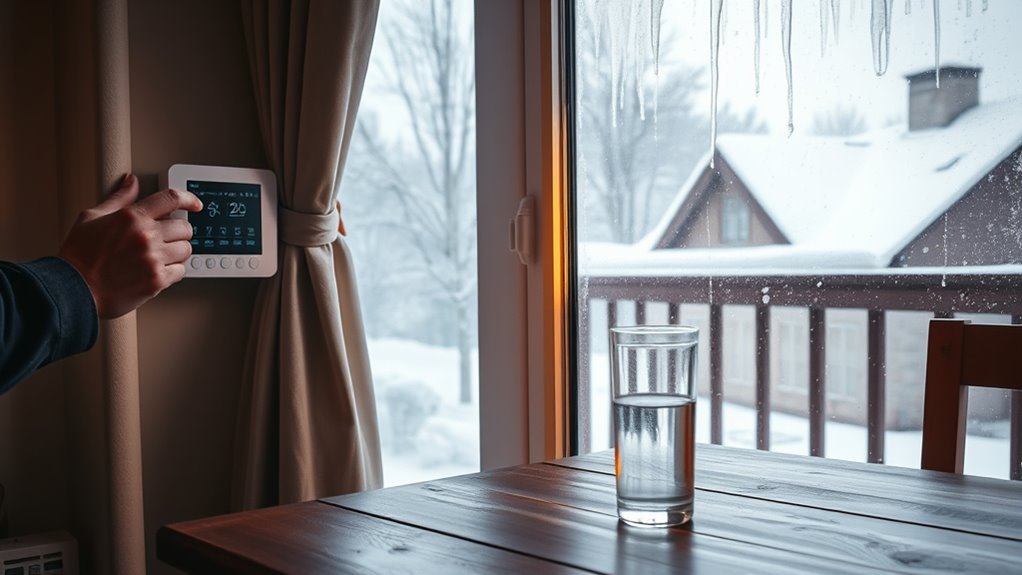
During an ice-storm outage, managing indoor temperature and water flow is essential to prevent pipes from freezing and maintain a safe, livable environment. Start by closing unused rooms to concentrate heat where it’s needed most, and use towels or draft stoppers under doors to block cold air infiltration. Cover windows at night with shades, blankets, or sheets to reduce heat loss. Dress in layers indoors to stay warm and minimize the need for extra heating. To prevent freezing, let a small trickle of water run through vulnerable faucets, and open cabinet doors to allow warmer air around pipes. Know the main water shut-off valve and be ready to turn it off if pipes burst. Regularly monitor indoor temperatures near plumbing to avoid freezing conditions. Additionally, ensuring proper filtration systems can help maintain indoor air quality and prevent dust buildup that could interfere with heating efficiency. Proper insulation of pipes is also crucial in preventing freezing hazards and should be considered as part of your emergency preparedness plan.
Shutting Off External Water Sources and Draining Outdoor Lines
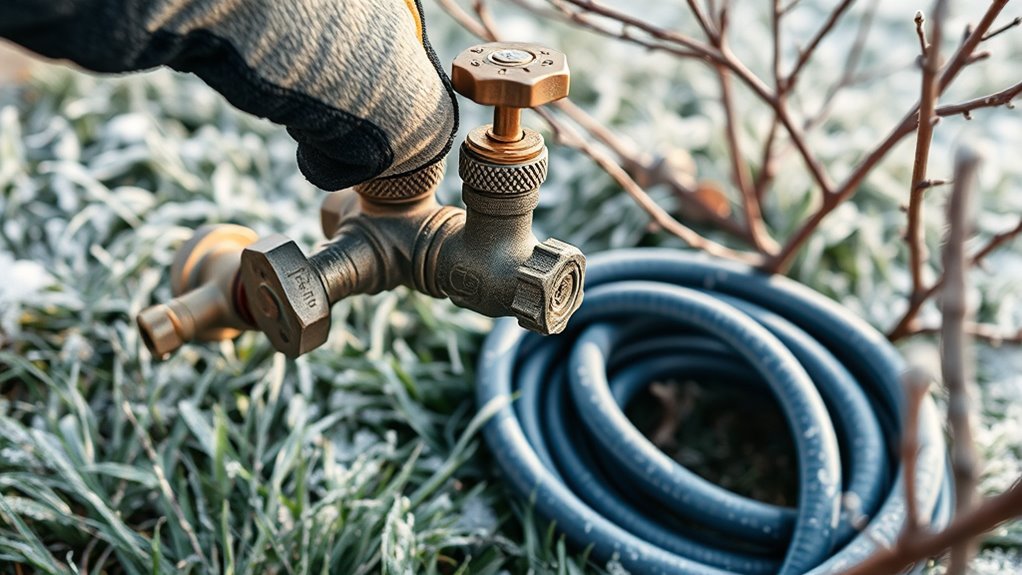
Are outdoor water lines at risk during an ice-storm? Yes, if you don’t shut off and drain them properly. First, locate your outdoor water shut-off valve, usually inside your home, near where the pipes branch out. Turn it off to stop water flow to external lines. Next, open outdoor faucets to drain any remaining water, preventing freezing and expansion. Disconnect all garden hoses and fully drain them before storing indoors, avoiding damage from trapped water. If you have irrigation systems, use their drain valves to clear water. Applying foam insulation to exposed pipes and faucet covers adds extra protection. Properly shutting off and draining outdoor water sources safeguards your plumbing from costly burst pipes and damage caused by freezing temperatures.
Using Safe Heating Devices to Prevent Freezing
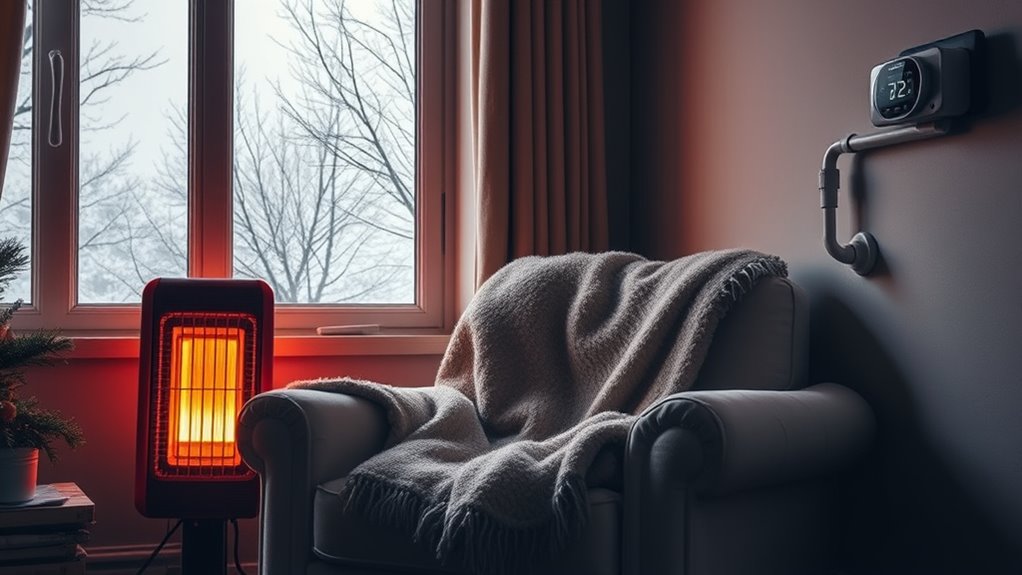
When using heating devices to prevent pipes from freezing, always choose approved models designed for safety and efficiency. Make sure your space is well-ventilated to avoid dangerous fumes, especially with portable heaters or heat tapes. Additionally, store fuel safely, keeping it away from heat sources to prevent fire hazards during cold weather.
Choose Approved Heating Devices
Choosing approved heating devices is essential for safely preventing pipe freezing. Always select devices that are UL listed or certified by recognized safety organizations to ensure they meet safety standards. Use thermostatic freeze protection valves, electric heat tracing cables, or self-regulating pipe heating cables to maintain safe temperatures. Wrap heat tape around vulnerable small or localized pipes, and consider portable options like electric heating pads or space heaters for targeted heating. Avoid extension cords for permanent installations and always use GFCI protection, especially in damp areas. Regularly inspect and replace damaged heat tapes or cables to prevent malfunctions. Ensure your devices are suitable for the environment—outdoor, damp, or enclosed spaces—and follow manufacturer instructions for safe, effective pipe protection during ice storms. Incorporating proper safety measures is crucial to prevent electrical hazards and ensure reliable operation during emergencies. Additionally, selecting devices with appropriate safety certifications helps minimize risks associated with electrical faults. Being aware of relationships and trust issues can also help you stay calm and focused during stressful weather events, ensuring you can address problems safely and effectively.
Ensure Proper Ventilation
Maintaining proper ventilation during winter is crucial for preventing frozen pipes, especially when using safe heating devices. Good airflow helps keep indoor temperatures stable, reducing cold drafts that can chill pipes. Keep interior doors open to promote air circulation around plumbing, particularly in cabinets and closets where pipes are hidden. Proper ventilation also prevents moisture buildup, lowering the risk of ice dams near pipes. Regularly monitor and maintain your ventilation systems to ensure continuous airflow and consistent temperature control in vulnerable areas. Avoid sealing spaces too tightly, as stagnant cold air can cause pipes to freeze. Using well-ventilated heating devices, like approved space heaters, combined with good airflow, helps warm the environment and protects your plumbing during winter storms. Additionally, understanding projector technology can help in planning indoor spaces for optimal comfort and energy efficiency during cold weather. Ensuring proper ventilation can also prevent indoor humidity levels from becoming too high, which might contribute to other winter-related issues. Incorporating ventilation fans in key areas can further enhance airflow and temperature regulation to protect your pipes effectively. Proper air exchange is essential to maintain a healthy indoor environment and prevent issues related to excess moisture.
Maintain Safe Fuel Storage
Proper fuel storage helps guarantee your heating devices operate safely and reliably during winter storms. Store fuel in approved containers and locations—away from heat, sparks, or sunlight—to prevent leaks, fires, and fumes. Keep containers on shelves or tables, not the ground, to reduce static and moisture risks. Clearly label and tightly seal all containers to prevent contamination and evaporation. Use fuel stabilizers, adding about 2 ounces per 5 gallons, to keep fuel fresh for up to a year, and rotate stock annually. When refueling, ensure devices are off and cooled, and use funnels to minimize spills. Store extra fuel away from heating devices. Regular maintenance and proper storage protect both your safety and your equipment. Monitoring and adjusting your fuel storage practices can also prevent issues like frozen pipes during cold weather. Additionally, understanding Gold IRA Rollovers can enhance your long-term financial security by diversifying your retirement investments.
Protecting Your Plumbing During Extreme Cold
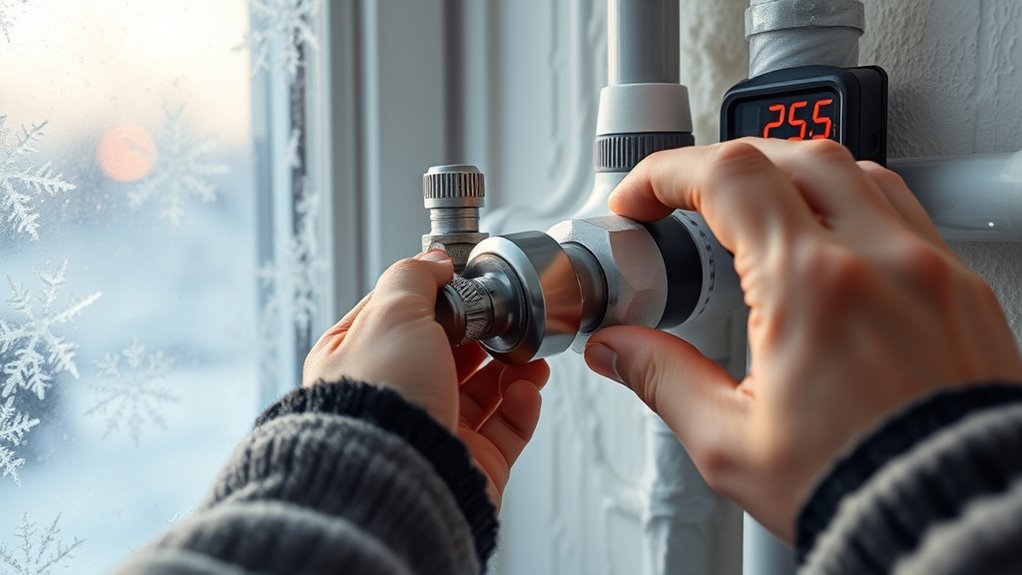
To keep your plumbing safe during extreme cold, it is essential to take proactive steps to prevent pipes from freezing. Insulate pipes in unheated spaces like attics, crawl spaces, garages, and basements with foam sleeves or pipe-insulating materials. Adding extra insulation around exterior walls where plumbing runs helps maintain warmth. Regularly inspect insulation for damage or wear, especially in energy-efficient homes. Use heated tape or heat cable that activates near freezing temperatures for added protection. Maintain indoor temperatures between 55 and 65 degrees Fahrenheit, and consider space heaters in vulnerable areas, ensuring they’re plugged into GFCI outlets. Keep cabinet doors open under sinks to allow warmer air to circulate. Incorporating sound design techniques such as subtle ambient sounds of dripping water or winter winds can also serve as early sensory cues of potential issues. Using insulation materials effectively can significantly enhance your home’s defenses against freezing. Being aware of frozen pipes symptoms, such as unusual noises or reduced water flow, can help you respond promptly. These simple measures can considerably reduce the risk of frozen pipes during extreme cold.
Monitoring Utility Updates and Reporting Hazards

Have you ever wondered how utilities keep the power grid stable during winter storms? They constantly monitor the system using advanced technology to track frequency, detect outages, and identify hazards. If the grid’s frequency shifts above or below 60 Hz, operators adjust generator output in real-time to maintain balance. Automated systems also alert crews quickly when outages occur, allowing rapid response. Customers play a crucial role by reporting flickering, outages, or hazards like downed wires through dedicated phone lines or online portals. These reports help utilities verify issues and prioritize repairs. During severe storms, close monitoring and hazard reporting ensure quicker response times, preventing prolonged outages and safeguarding public safety. Staying informed and reporting hazards keeps the grid stable and your community safer. Additionally, understanding how vegetable juices can support health may motivate residents to take proactive steps for overall well-being during emergency situations. Moreover, leveraging market research can help utilities identify high-risk areas and optimize resource allocation for preventive measures. Effective communication and timely hazard reporting are essential for maintaining power reliability during adverse weather conditions.
Preparing Emergency Supplies and Food Storage
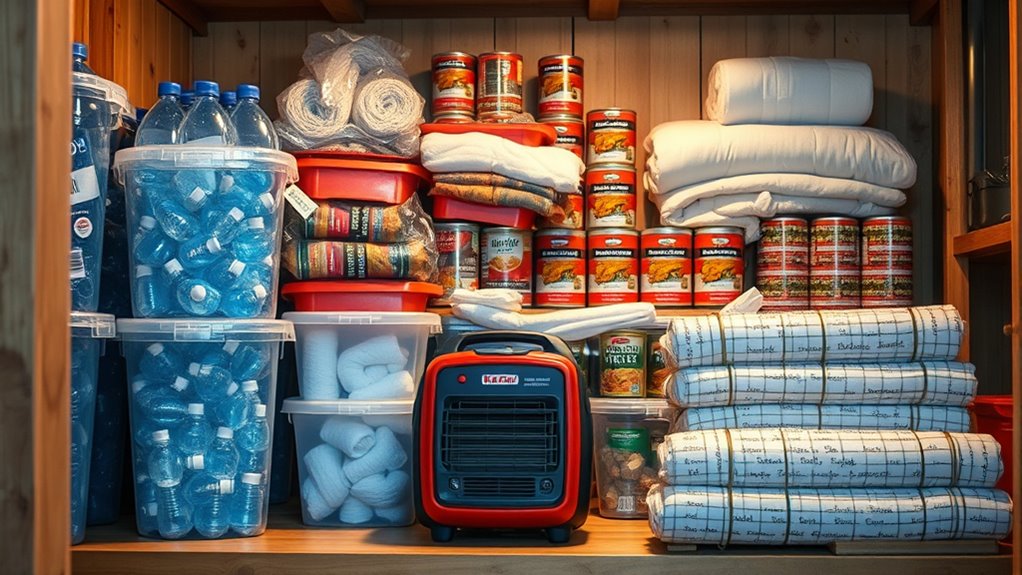
Preparing for ice-storm outages involves assembling and maintaining a reliable supply of emergency food and supplies to guarantee safety and sustenance when power lines go down. Start by stocking non-perishable foods that don’t require refrigeration, like canned goods, dried fruits, and grains. Keep a two-week supply and regularly rotate items to ensure freshness. Store extra ice or cold packs to help keep perishables cold during extended outages. Use blankets or newspapers to insulate freezers, and limit door openings to preserve cold air. If power is out for more than four hours, transfer perishables to a cooler with ice. Mark and consume refrozen foods promptly, discarding anything that shows signs of spoilage. Have tools ready to check food temperatures and determine safety. Proper planning minimizes waste and keeps your family safe.
Practicing Safety During Power Outages and Storm Conditions
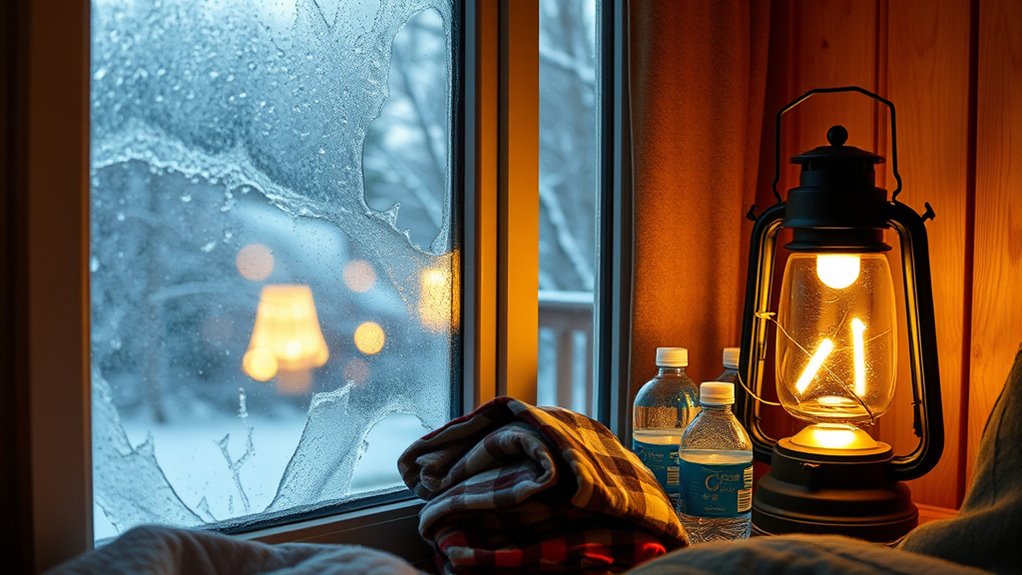
To stay safe during power outages and storms, you need to know how to use generators properly and avoid electrical hazards. Managing your electrical devices carefully diminishes the risk of damage and injury, especially during storm conditions. Practicing emergency drills now ensures you’re prepared to respond quickly and safely when an outage occurs.
Use Generators Safely
Using generators safely during power outages and storm conditions is essential to protect yourself and others from injury or carbon monoxide poisoning. Never connect a generator directly to your home wiring without a professional-installed transfer switch, which prevents backfeeding and hazards to utility workers. Always operate generators outdoors in well-ventilated areas, away from windows, doors, and vents. Use heavy-duty, outdoor-rated extension cords with proper grounding, and avoid damaged cords. Turn off the generator and let it cool before refueling to prevent fires. Store fuel in approved containers away from ignition sources. Follow manufacturer instructions and consult professionals for proper installation and grounding.
| Safety Aspect | Key Practice |
|---|---|
| Electrical Connection | Use transfer switches, avoid direct wall outlet plugging |
| Carbon Monoxide Risks | Operate outside, install detectors |
| Fuel Handling | Store fuels properly, turn off generator before refueling |
| Weather Conditions | Keep generator dry, avoid operation in rain |
| Equipment Maintenance | Follow manufacturer instructions, inspect cords |
Manage Electrical Devices
Managing electrical devices during power outages and storm conditions helps prevent damage and keeps you safe. Turn off and unplug major electronics, like computers and TVs, to avoid surge damage when power returns. Wait several minutes before turning appliances back on, powering them up one at a time to prevent overloads. Leave one light on to signal when power is restored. Use flashlights with fresh batteries instead of candles to reduce fire risk. Keep refrigerators closed and check food temperatures afterward to prevent spoilage. Ensure cords are in good condition, never overload outlets or extension cords, and select certified, rated cords for safety. Use surge protectors for sensitive electronics, and keep electrical devices away from water sources to avoid electrocution. Reset circuit breakers cautiously after outages, and report issues promptly.
Practice Emergency Drills
Practicing emergency drills is essential for ensuring your family is prepared to handle power outages and winter storms effectively. Regular drills help identify gaps and improve response times. During these exercises, focus on:
- Simulating ice-storm scenarios, including extended outages and infrastructure damage, to test contingency plans and resource management for at least three days.
- Practicing quick deployment of emergency supply kits with non-perishable food, water, medications, and cash, ensuring accessibility and familiarity.
- Training on safety skills like recognizing cold-related conditions, using portable heaters safely, and maintaining communication through radios and alerts.
Frequently Asked Questions
How Can I Prevent Pipes From Freezing Without Excessive Insulation?
To prevent pipes from freezing without excessive insulation, keep water moving by letting faucets drip slowly, especially those farthest from the main valve. Open cabinet doors to let warm air circulate around pipes, and set your thermostat above 55°F. Disconnect outdoor hoses and install freeze-misers on outdoor faucets to allow a controlled drip. These simple steps help keep water flowing and reduce the risk of freezing, without bulky insulation.
What Are the Best Ways to Keep Indoor Water Flowing During a Storm?
To keep indoor water flowing during a storm, you should set your thermostat to at least 55°F, ensuring a steady, warm environment. Let faucets drip slowly to keep water moving, and open cabinet doors to invite warmth around pipes. Maintain consistent heating, avoid lowering temperatures at night, and monitor water pressure. These proactive practices prevent pipes from freezing and keep your water running smoothly throughout the storm.
How Do I Safely Shut off My Home’s Water Supply?
To safely shut off your home’s water supply, locate the main shut-off valve, usually near where the water enters your home. Turn the valve clockwise or a quarter turn perpendicular, depending on the type. After closing it, open all faucets inside to drain remaining water and relieve pressure. Confirm the water’s off, keep the area accessible, and practice this procedure regularly to make sure you’re prepared during emergencies.
Which Indoor Heating Devices Are Safest During Power Outages?
When the power’s out and warmth is critical, you want the safest indoor heating devices. Portable propane heaters with oxygen depletion sensors are a good choice, as they shut off automatically if oxygen drops too low. Catalytic heaters are even safer—they produce heat without flames and don’t rely on electricity. Just remember to keep ventilation open, install carbon monoxide alarms, and never leave heaters unattended for maximum safety during outages.
How Do I Detect and Respond to Signs of Frozen Pipes Early?
You can detect frozen pipes early by checking for frost or ice on exposed pipes, bulging sections, or cracks. Listen for banging or gurgling sounds, and look for damp spots or water stains on walls or ceilings. If you notice these signs, increase your indoor temperature slightly, and call a plumber promptly. Acting quickly prevents pipes from bursting, saving you from costly repairs and water damage.
Conclusion
By taking these proactive steps, you can keep your pipes safe and stay comfortable during an ice storm. Some experts believe that maintaining a slight indoor temperature consistently prevents freezing better than sporadic heating. So, don’t wait until the storm hits—prepare now. With the right precautions, you might just find that staying warm and dry isn’t as hard as you think. After all, a little planning can make all the difference when the weather turns harsh.

